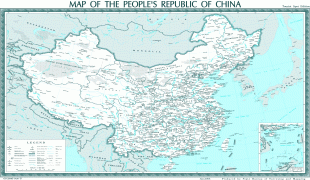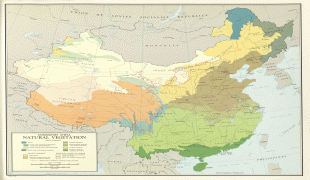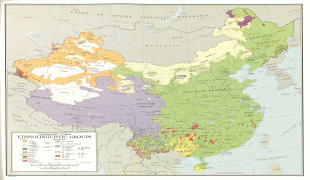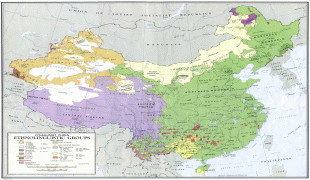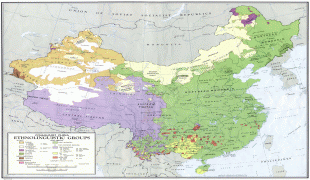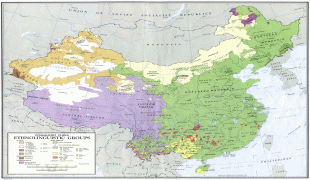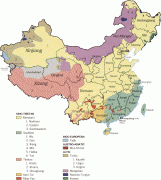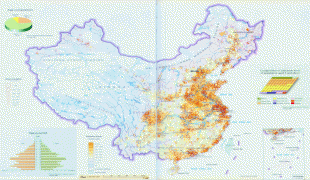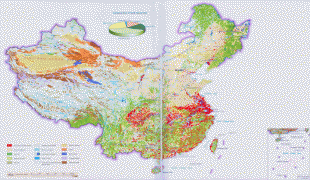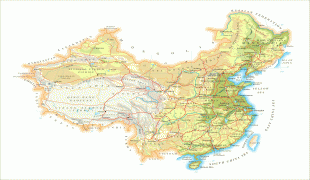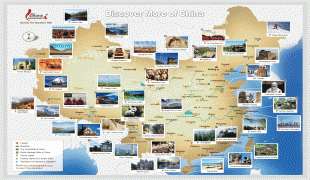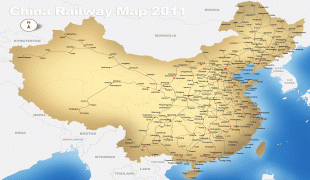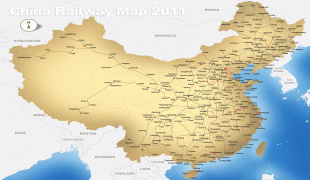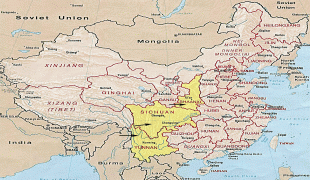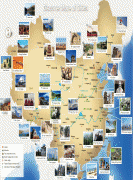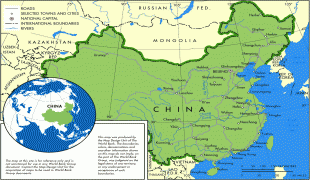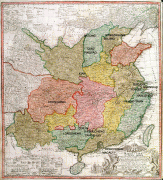China (People’s Republic of China)
 |
 |
| Flag of China | |
Modern Chinese trace their origins to a cradle of civilization in the fertile basin of the Yellow River in the North China Plain. The semi-legendary Xia dynasty in the 21st century BCE and the well-attested Shang and Zhou dynasties developed a bureaucratic political system to serve hereditary monarchies, or dynasties. Chinese writing, Chinese classic literature, and the Hundred Schools of Thought emerged during this period and influenced China and its neighbors for centuries to come. In the third century BCE, Qin's wars of unification created the first Chinese empire, the short-lived Qin dynasty. The Qin was followed by the more stable Han dynasty (206 BCE–220 CE), which established a model for nearly two millennia in which the Chinese empire was one of the world's foremost economic powers. The empire expanded, fractured, and reunified; was conquered and reestablished; absorbed foreign religions and ideas; and made world-leading scientific advances, such as the Four Great Inventions: gunpowder, paper, the compass, and printing. After centuries of disunity following the fall of the Han, the Sui (581–618) and Tang (618–907) dynasties reunified the empire. The multi-ethnic Tang welcomed foreign trade and culture that came over the Silk Road and adapted Buddhism to Chinese needs. The early modern Song dynasty (960–1279) became increasingly urban and commercial. The civilian scholar-officials or literati used the examination system and the doctrines of Neo-Confucianism to replace the military aristocrats of earlier dynasties. The Mongol invasion established the Yuan dynasty in 1279, but the Ming dynasty (1368–1644) re-established Han Chinese control. The Manchu-led Qing dynasty nearly doubled the empire's territory and established a multi-ethnic state that was the basis of the modern Chinese nation, but suffered heavy losses to foreign imperialism in the 19th century.
The Chinese monarchy collapsed in 1912 with the Xinhai Revolution, when the Republic of China (ROC) replaced the Qing dynasty. In its early years as a republic, the country underwent a period of instability known as the "Warlord Era" before mostly reunifying in 1928 under a Nationalist government. A civil war between the nationalist Kuomintang (KMT) and the Chinese Communist Party (CCP) began in 1927. Japan invaded China in 1937, starting the Second Sino-Japanese War and temporarily halting the civil war. The surrender and expulsion of Japanese forces from China in 1945 left a power vacuum in the country, which led to renewed fighting between the CCP and the Kuomintang. The civil war ended in 1949 with the division of Chinese territory; the CCP established the People's Republic of China on the mainland while the Kuomintang-led ROC government retreated to the island of Taiwan. Both claim to be the sole legitimate government of China, although the United Nations has recognized the PRC as the sole representation since 1971. From 1959 to 1961, the PRC implemented an economic and social campaign called the "Great Leap Forward" that resulted in a sharp economic decline and an estimated 15 to 55 million deaths, mostly through man-made famine. From 1966 to 1976, the turbulent period of political and social chaos within China known as the Cultural Revolution led to greater economic and educational decline, with millions being purged or subjected to either persecution or "politicide" based on political categories. Since then, the Chinese government has rebuked some of the earlier Maoist policies, conducting a series of political and economic reforms since 1978 that have greatly raised Chinese standards of living, and increased life expectancies.
China is currently governed as a unitary Marxist–Leninist one-party socialist republic by the CCP. China is a permanent member of the United Nations Security Council and a founding member of several multilateral and regional cooperation organizations such as the Asian Infrastructure Investment Bank, the Silk Road Fund, the New Development Bank, the Shanghai Cooperation Organisation, and the RCEP. It is also a member of the BRICS, the G8+5, the G20, the APEC, and the East Asia Summit. It ranks among the lowest in measurements of democracy, civil liberties, government transparency, freedom of the press, freedom of religion, and the human rights of ethnic minorities. The Chinese authorities have been criticized by human rights activists and non-governmental organizations for human rights abuses, including political repression, mass censorship, mass surveillance of their citizens, and violent suppression of protest and dissent.
Making up around one-fifth of the world economy, China is the world's largest economy by GDP at purchasing power parity, the second-largest economy by nominal GDP, and the second-wealthiest country. The country is one of the fastest-growing major economies and is the world's largest manufacturer and exporter, as well as the second-largest importer. China is a recognized nuclear-weapon state with the world's largest standing army by military personnel and the second-largest defense budget. China is considered to be a potential superpower due to its high level of innovation, economic potential, growing military strength, and influence in international affairs.
The word "China" has been used in English since the 16th century; however, it was not a word used by the Chinese themselves during this period. Its origin has been traced through Portuguese, Malay, and Persian back to the Sanskrit word Chīna, used in ancient India. "China" appears in Richard Eden's 1555 translation of the 1516 journal of the Portuguese explorer Duarte Barbosa. Barbosa's usage was derived from Persian Chīn, which was in turn derived from Sanskrit Cīna. Cīna was first used in early Hindu scripture, including the Mahābhārata (5th century BCE) and the Laws of Manu (2nd century BCE). In 1655, Martino Martini suggested that the word China is derived ultimately from the name of the Qin dynasty (221–206 BCE). Although usage in Indian sources precedes this dynasty, this derivation is still given in various sources. The origin of the Sanskrit word is a matter of debate, according to the Oxford English Dictionary. Alternative suggestions include the names for Yelang and the Jing or Chu state. The official name of the modern state is the "People's Republic of China". The shorter form is "China" ' from ' ("central") and ("state"), a term which developed under the Western Zhou dynasty in reference to its royal demesne. It was then applied to the area around Luoyi (present-day Luoyang) during the Eastern Zhou and then to China's Central Plain before being used as an occasional synonym for the state under the Qing. It was often used as a cultural concept to distinguish the Huaxia people from perceived "barbarians". The name Zhongguo is also translated as "Middle Kingdom" in English. China (PRC) is sometimes referred to as the Mainland when distinguishing the ROC from the PRC.
Currency / Language
| ISO | Currency | Symbol | Significant figures |
|---|---|---|---|
| CNY | Renminbi | ¥ or 元 | 2 |
| ISO | Language |
|---|---|
| ZH | Chinese language |
| UG | Uighur language |
| ZA | Zhuang language |






